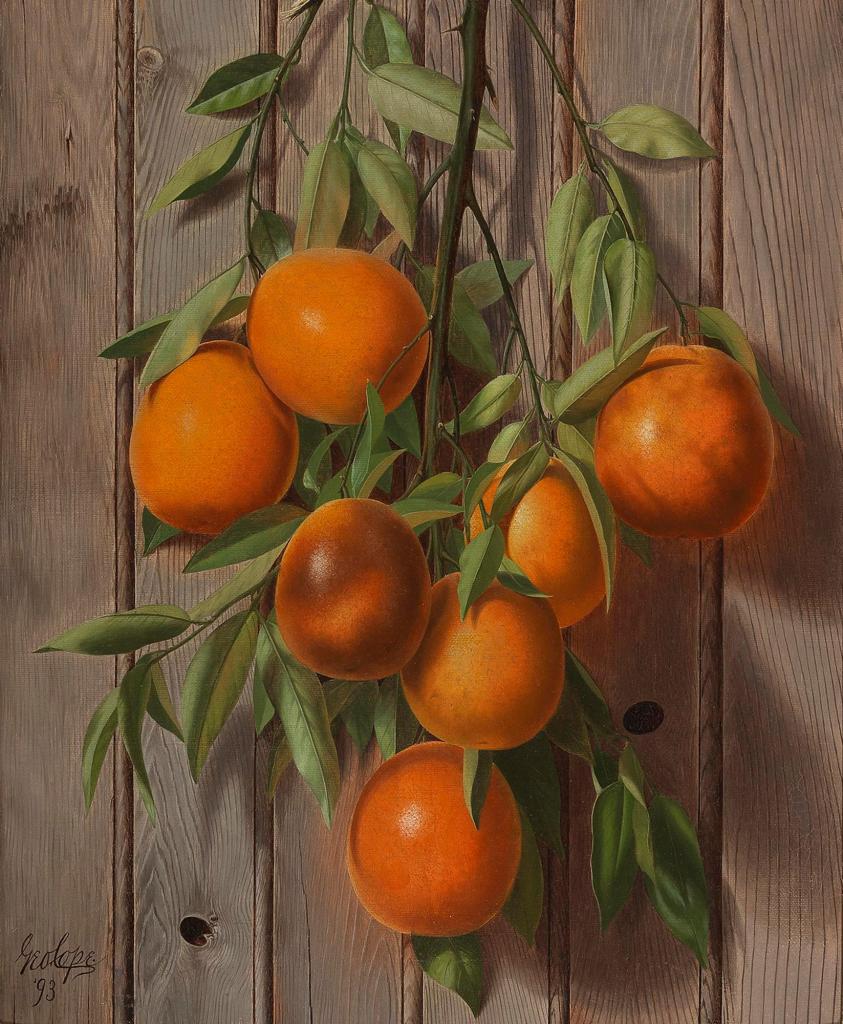
Artist:
George Cope
(American, 1855 - 1929)
Oranges
Medium: Oil on canvas
Date: 1893
Dimensions:
16 × 20 in. (40.6 × 50.8 cm)
Accession number: 90.9
Label Copy:
George Cope was born in 1855 near West Chester, Pennsylvania, and though he spent most of his life in the Chester County area, between 1881 and 1883 he lived in Philadelphia. It was during this period that he began to paint still lifes and, in particular, trompe l’oeil. "Oranges" is an example of this clever painting style that fools the eye into believing that a two-dimensional painting is actually a three-dimensional object.
In a newspaper interview from the 1920s, Cope explained how he came to take up still-life painting: "…One day I was at the machine shops and foundry at Cope’s Bridge, on the Brandywine, owned and operated by E.T. Cope and Sons. Major Emmor B. Cope, late of Gettysburg, then a young man had a decided talent for art. He called me into the office and taking down a board from the wall which looked like it had a knife and a bunch of keys on it, he asked me which I would prefer. They were so well painted that they looked real. I was so taken by the trick that right then I resolved if I lived long enough, I would paint something that would fool someone too…"
This painting shows oranges which are still attached to the branches like flowers attached to their stems in a bouquet. These may have been grown locally, as they appear to be a heartier variety (as evidenced by the thorns) which grew in colder climates, including as far north as Pennsylvania. Nowadays we see less of this variety of orange tree, probably due to the bitter taste of its fruit, which for many makes it inedible.
The trompe l’oeil effect can be seen in the wooden wall or door, as well as the oranges, foliage, and branches, which were all painted to appear real, and where shadowing was used to give a three-dimensional effect, so as to "trick" the eye.
George Cope was born in 1855 near West Chester, Pennsylvania, and though he spent most of his life in the Chester County area, between 1881 and 1883 he lived in Philadelphia. It was during this period that he began to paint still lifes and, in particular, trompe l’oeil. "Oranges" is an example of this clever painting style that fools the eye into believing that a two-dimensional painting is actually a three-dimensional object.
In a newspaper interview from the 1920s, Cope explained how he came to take up still-life painting: "…One day I was at the machine shops and foundry at Cope’s Bridge, on the Brandywine, owned and operated by E.T. Cope and Sons. Major Emmor B. Cope, late of Gettysburg, then a young man had a decided talent for art. He called me into the office and taking down a board from the wall which looked like it had a knife and a bunch of keys on it, he asked me which I would prefer. They were so well painted that they looked real. I was so taken by the trick that right then I resolved if I lived long enough, I would paint something that would fool someone too…"
This painting shows oranges which are still attached to the branches like flowers attached to their stems in a bouquet. These may have been grown locally, as they appear to be a heartier variety (as evidenced by the thorns) which grew in colder climates, including as far north as Pennsylvania. Nowadays we see less of this variety of orange tree, probably due to the bitter taste of its fruit, which for many makes it inedible.
The trompe l’oeil effect can be seen in the wooden wall or door, as well as the oranges, foliage, and branches, which were all painted to appear real, and where shadowing was used to give a three-dimensional effect, so as to "trick" the eye.
Curatorial RemarksINSCRIPTIONS/MARKS; SIGNATURE; INSCRIBED DATE